Abstract
The therapeutic efficacy of orally administered zidovuldine (3'-azido-3'-deoxythymidine) was determined in animals infected with Escherichia coli and Salmonella dublin. The 50% effective dose (ED50) of zidovudine (9.6 to 11.8 mg/kg of body weight) compared favorably with that of trimethoprim (19.4 to 22.2 mg/kg) in mice with systemic E. coli infection. At 50 mg/kg, both zidovudine and ampicillin reduced the number of bacteria in the kidneys of mice and prevented lethal infection in mice with ascending pyelonephritis caused by E. coli. Zidovudine prevented a lethal S. dublin infection in calves over a wide dose range (8.0 to 31.0 mg/kg per day). Zidovudine levels in plasma of uninfected mice were 28.2 +/- 4.5 and 7.9 +/- 2.2 micrograms/ml at 30 and 60 min, respectively, exceeding the MICs for the bacteria used in the infections. Few zidovudine-resistant strains were observed. The in vivo data raise the possibility that zidovudine may have an antibacterial effect in patients receiving this therapy.
Full text
PDF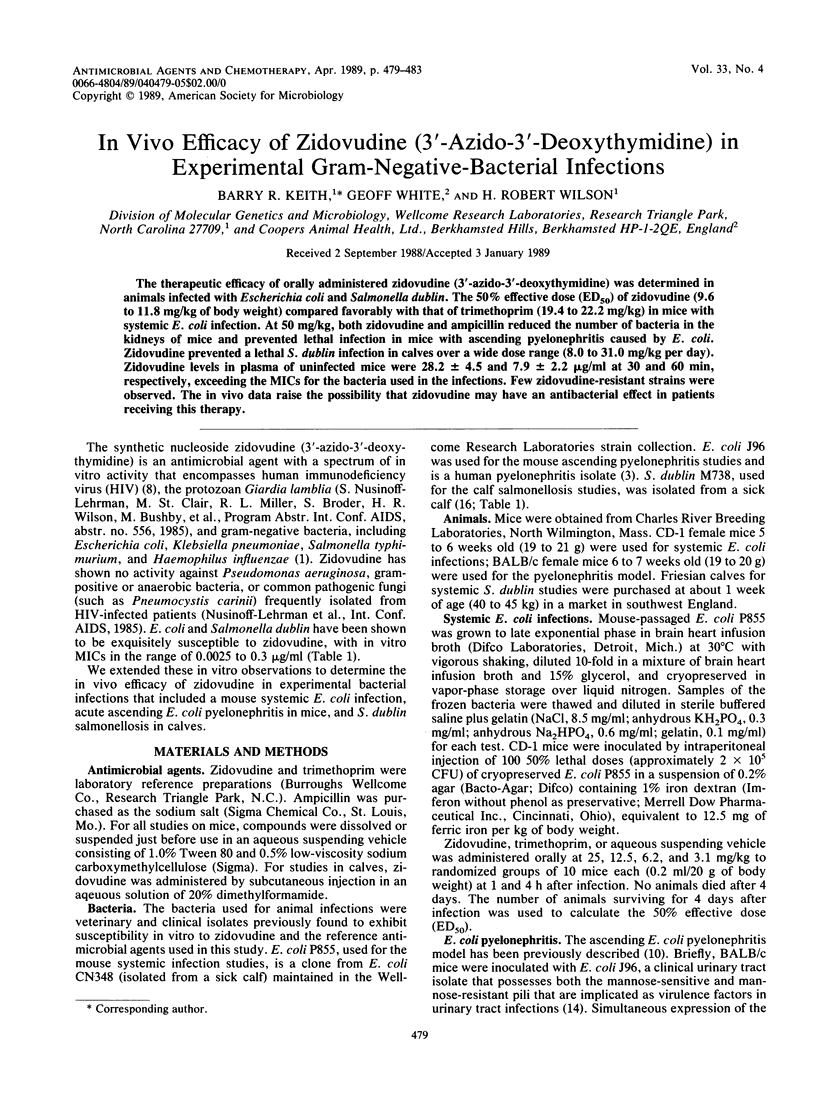
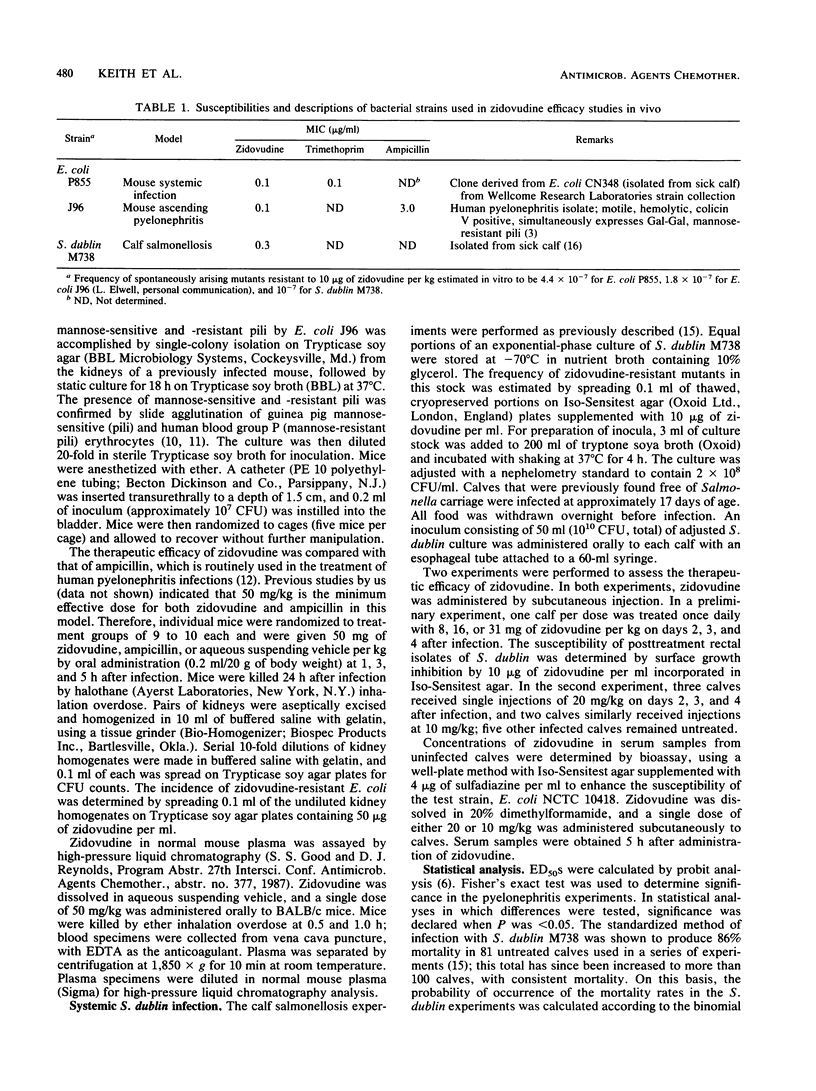
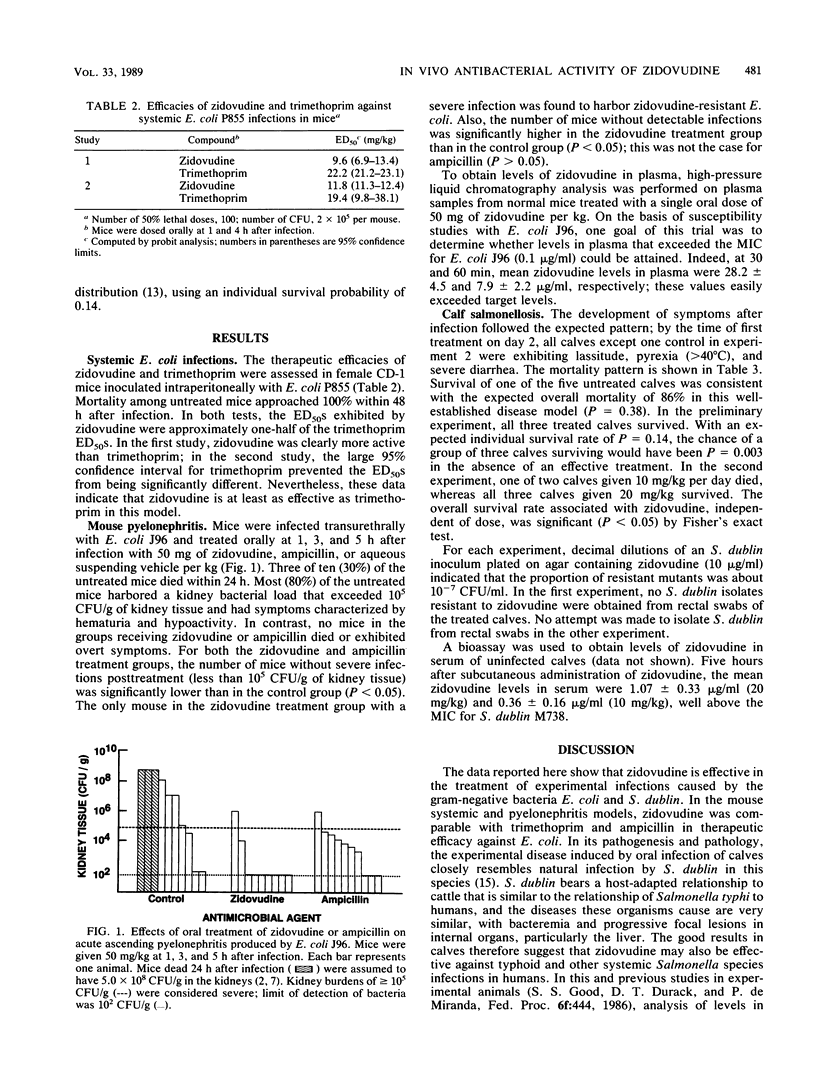
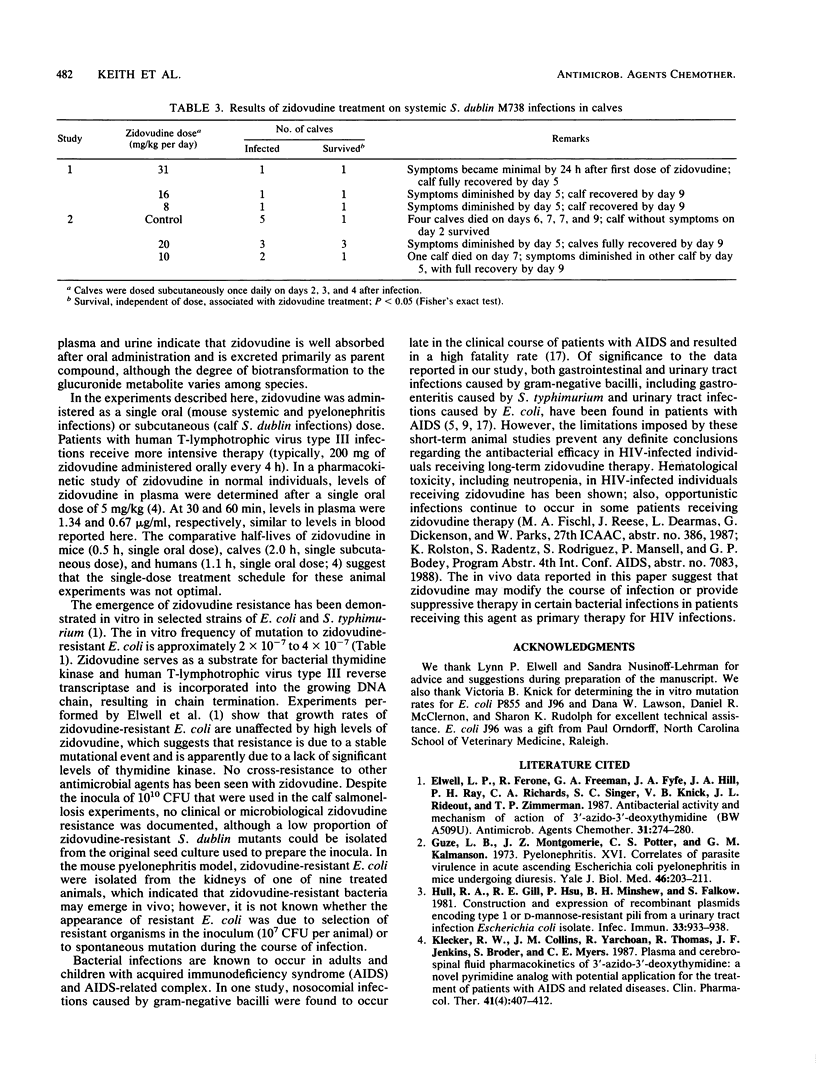
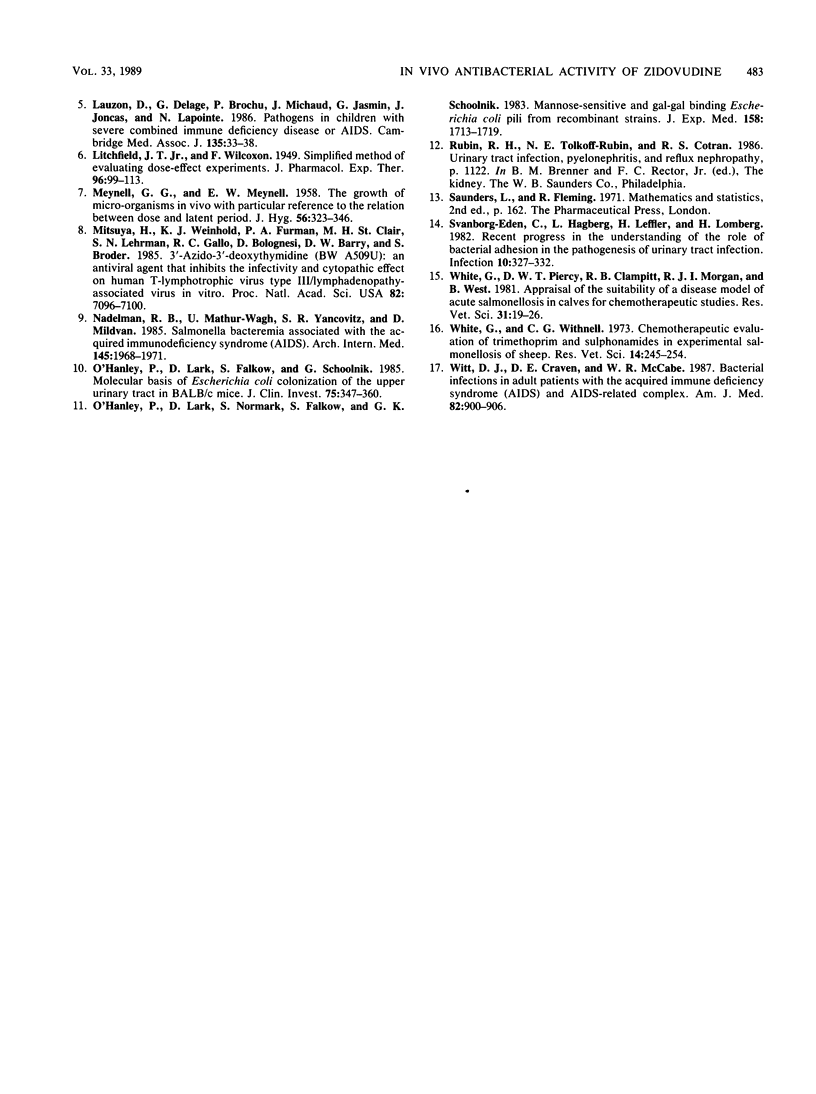
Selected References
These references are in PubMed. This may not be the complete list of references from this article.
- Elwell L. P., Ferone R., Freeman G. A., Fyfe J. A., Hill J. A., Ray P. H., Richards C. A., Singer S. C., Knick V. B., Rideout J. L. Antibacterial activity and mechanism of action of 3'-azido-3'-deoxythymidine (BW A509U). Antimicrob Agents Chemother. 1987 Feb;31(2):274–280. doi: 10.1128/aac.31.2.274. [DOI] [PMC free article] [PubMed] [Google Scholar]
- Guze L. B., Montgomerie J. Z., Potter C. S., Kalmanson G. M. Pyelonephritis XVI. correlates of parasite virulence in acute ascending Escherichia coli pyelonephritis in mice undergoing diuresis. Yale J Biol Med. 1973 Jun;46(3):203–211. [PMC free article] [PubMed] [Google Scholar]
- Hull R. A., Gill R. E., Hsu P., Minshew B. H., Falkow S. Construction and expression of recombinant plasmids encoding type 1 or D-mannose-resistant pili from a urinary tract infection Escherichia coli isolate. Infect Immun. 1981 Sep;33(3):933–938. doi: 10.1128/iai.33.3.933-938.1981. [DOI] [PMC free article] [PubMed] [Google Scholar]
- Klecker R. W., Jr, Collins J. M., Yarchoan R., Thomas R., Jenkins J. F., Broder S., Myers C. E. Plasma and cerebrospinal fluid pharmacokinetics of 3'-azido-3'-deoxythymidine: a novel pyrimidine analog with potential application for the treatment of patients with AIDS and related diseases. Clin Pharmacol Ther. 1987 Apr;41(4):407–412. doi: 10.1038/clpt.1987.49. [DOI] [PubMed] [Google Scholar]
- Lauzon D., Delage G., Brochu P., Michaud J., Jasmin G., Joncas J. H., Lapointe N. Pathogens in children with severe combined immune deficiency disease or AIDS. CMAJ. 1986 Jul 1;135(1):33–38. [PMC free article] [PubMed] [Google Scholar]
- MEYNELL G. G., MEYNELL E. W. The growth of micro-organisms in vivo with particular reference to the relation between dose and latent period. J Hyg (Lond) 1958 Sep;56(3):323–346. doi: 10.1017/s0022172400037827. [DOI] [PMC free article] [PubMed] [Google Scholar]
- Mitsuya H., Weinhold K. J., Furman P. A., St Clair M. H., Lehrman S. N., Gallo R. C., Bolognesi D., Barry D. W., Broder S. 3'-Azido-3'-deoxythymidine (BW A509U): an antiviral agent that inhibits the infectivity and cytopathic effect of human T-lymphotropic virus type III/lymphadenopathy-associated virus in vitro. Proc Natl Acad Sci U S A. 1985 Oct;82(20):7096–7100. doi: 10.1073/pnas.82.20.7096. [DOI] [PMC free article] [PubMed] [Google Scholar]
- Nadelman R. B., Mathur-Wagh U., Yancovitz S. R., Mildvan D. Salmonella bacteremia associated with the acquired immunodeficiency syndrome (AIDS). Arch Intern Med. 1985 Nov;145(11):1968–1971. [PubMed] [Google Scholar]
- O'Hanley P., Lark D., Falkow S., Schoolnik G. Molecular basis of Escherichia coli colonization of the upper urinary tract in BALB/c mice. Gal-Gal pili immunization prevents Escherichia coli pyelonephritis in the BALB/c mouse model of human pyelonephritis. J Clin Invest. 1985 Feb;75(2):347–360. doi: 10.1172/JCI111707. [DOI] [PMC free article] [PubMed] [Google Scholar]
- O'Hanley P., Lark D., Normark S., Falkow S., Schoolnik G. K. Mannose-sensitive and Gal-Gal binding Escherichia coli pili from recombinant strains. Chemical, functional, and serological properties. J Exp Med. 1983 Nov 1;158(5):1713–1719. doi: 10.1084/jem.158.5.1713. [DOI] [PMC free article] [PubMed] [Google Scholar]
- Svanborg Edén C., Hagberg L., Leffler H., Lomberg H. Recent progress in the understanding of the role of bacterial adhesion in the pathogenesis of urinary tract infection. Infection. 1982 Sep-Oct;10(5):327–332. doi: 10.1007/BF01640890. [DOI] [PubMed] [Google Scholar]
- White G., Piercy D. W., Clampitt R. B., Morgan R. J., West B. Appraisal of the suitability of a disease model of acute salmonellosis in calves for chemotherapeutic studies. Res Vet Sci. 1981 Jul;31(1):19–26. [PubMed] [Google Scholar]
- White G., Withnell C. G. Chemotherapeutic evaluation of trimethoprim and sulphonamides in experimental salmonellosis of sheep. Res Vet Sci. 1973 Mar;14(2):245–254. [PubMed] [Google Scholar]
- Witt D. J., Craven D. E., McCabe W. R. Bacterial infections in adult patients with the acquired immune deficiency syndrome (AIDS) and AIDS-related complex. Am J Med. 1987 May;82(5):900–906. doi: 10.1016/0002-9343(87)90150-1. [DOI] [PubMed] [Google Scholar]


